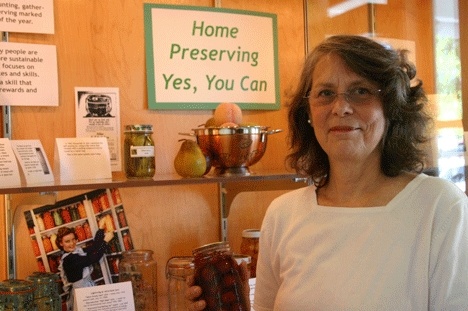Raspberries, cherries and blackberries, oh my.
Though the raspberries have come and gone, the cherries are hanging low, and soon the blackberries will be ready to pick by the bucketful. After that, apples will lay in heaps under the tree.
What to do with all that fruit?
Sue Ellen White has the answer. You can can.
No, not the French dance number.
Canning is the answer to all your food- preservation problems. After all, eating as much of the ripe fruit off the tree as possible would be difficult, even for a large family.
“People are happier to use things up rather than have it all go to waste,” White said.
“That’s why learning to can and preserve fruits and vegetables is so good.”
Head down to the Freeland Library and take a look at the colorful display White has set up on everything about food preservation.
White holds classes on canning at the Deer Lagoon Grange Hall in Langley. She said she’s reaching out to the community in order to revive an idea that can prove helpful in tough economic times.
“When that apple tree is laden with fruit and you think, ‘What am I going to do with all these apples,’ canning comes in very handy,” White said.
“You can preserve applesauce, apple pie filling and apple jelly. You don’t have to consider eating up all those apples before they rot.”
White even has an apple press, and invents splashy new juices in varying seasons.
In the summer of 1974, White kept a meticulous canning record which is part of the display. That summer, all her canning was done on a wood stove in an outdoor screened-in kitchen with a cold water spigot at Spring Valley Farm in the Maxwelton Valley.
Her formidable experience of growing organically, gleaning (collecting leftover crops from commercial farms), wildcrafting (gathering what grows wild in the area such as blackberries, clams, mushrooms, etc.) and preserving since 1972 serves her well. Eating largely from her garden and local sources for much of the year, White cans everything from apples and berry sauce, to tomato marmalade and zucchini relish.
Many islanders are seeking a more sustainable lifestyle that focuses on local resources and skills, White said, and canning is just another aspect of sustainability that makes sense, especially in this economy.
Ace Hardware in Freeland offers an inexpensive canning tool kit which has everything you need to get started, White said.
Although she has been canning since moving to Whidbey Island in the 1970s, White said she is not the first island proponent of preservation.
According to Lorna Cherry’s “South Whidbey And Its People, Volume II,” people weathered the Depression and other economic hard times by living off the land.
“Marie Burley, every year, put up 500 quarts of food — vegetables, fruits and meat — all without the aid of modern conveniences like an electric stove or pressure canners,” Omer Porter remembered.
The book also describes how the Depression influenced people to rally around each other to provide for each other and themselves, by making use of local food sources such as clams and berries.
“In the Maxwelton area, a canning project was begun during the Depression. For at least five years throughout the growing season, islanders could bring their produce to Woodland Hall and can it under the direction of a government-sponsored supervisor.
“During the canning season of 1939, according to research done by Leon Burley, the approximately 100 participating families prepared 17,093 cans of food,” Cherry wrote.
As White points out in her display, other periods in history also saw an uptick in food preserving.
The victory gardens of World War I and the rationing of World War II combined with increasingly better equipment to make home canning a somewhat patriotic duty, and a huge effort on the part of American families.
A good canning book is a must, White said, such as “Ball Blue Book of Preserving,” or “Ball Complete Book of Home Preserving,” both published by the famous Ball Corporation, makers of the ubiquitous Ball jar.
But, along with a good book, White recommends taking one of her hands-on classes that sends each student home with a jar of something they’ve preserved.
“I can offer the tricks of the trade that the book doesn’t tell you about,” White said.
“I’ll give you the inside scoop on everything to do with canning.”
For more info, go to the USDA food preservation Web site; click here.
Call White about local canning classes at 341-2434.
The display at the library is on until Friday.



